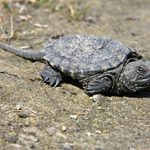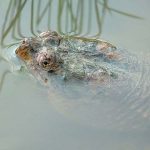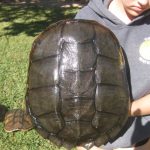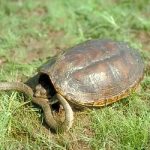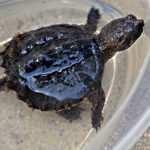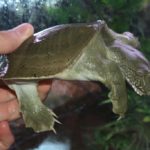Common Snapping Turtle
Common snapping turtles are large freshwater turtles belonging to the Chelydridae family, occurring in North America. They are nocturnal and are known to be very aggressive when caught. There are no recognized subspecies of this turtle.
| Kingdom | Animalia |
| Phylum | Chordata |
| Subphylum | Vertebrata |
| Class | Reptilia |
| Order | Testudines |
| Family | Chelydridae |
| Genus | Chelydra |
| Scientific Name | Chelydra serpentina |
| Other Names | Snapping Turtle, Snapper |
| Size | 25 – 50 cm |
| Weight | 4.5–16 kg; heaviest wild specimen weighed 34 kg |
| Color | Dull brown to black |
| Distribution | Southeastern Canada including Nova Scotia, eastern and central United States |
| Habitat | Ponds, muddy lakes, slow-moving rivers |
| Diet | Aquatic plants, frogs and tadpoles, fish, salamanders, snails, worms, leeches, insects, snakes, small mammals, baby ducks and goslings, carrion |
| Hibernation Fact | Some populations, especially those living in cold regions, have been found to hibernate; though some individuals may remain active even in ice |
| Predators | Juveniles fall prey to crows, minks, foxes, raccoons, skunks, herons, hawks, owls, bitterns, fishers, bullfrogs, large fishes, snakes |
| Breeding Season | April – November |
| Mode of Reproduction | Oviparous (egg laying) |
| Clutch Size | 25 to 80 eggs |
| Incubation Period | 2 to 4 months |
| Reproductive Age | Male: Around 5 years of age Females: Between 4 – 7 years |
| Average Lifespan | 30 to 40 years |
| IUCN Conservation Status | Least Concern |
Common Snapping Turtle Pictures Gallery
- Alligator Snapping Turtle vs Common Snapping Turtle
- Baby Common Snapping Turtle
- Common Snapping Turtle Habitat
- Common Snapping Turtle Images
- Common Snapping Turtle in Water
- Common Snapping Turtle Photos
- Common Snapping Turtle Pictures
- Common Snapping Turtle Shell
- Common Snapping Turtle
- Commo Snapping Turtles
- Images of Common Snapping Turtle
- Largest Common Snapping Turtle
- Chelydra Serpentina
- Common Snapping Turtle Tank Setup
- Common Snapping Turtle Care
- Common Snapping Turtle Diet
- Common Snapping Turtle Hatchling
- Common Snapping Turtle Pet



